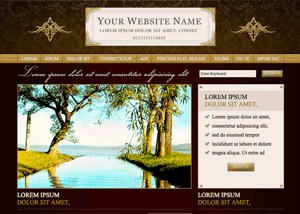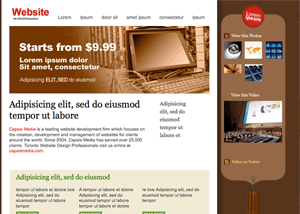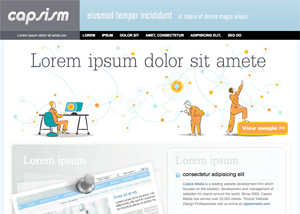Here’s my idea for a little OS X application, Twitter in the Finder Bar (of course, I would call it something better than that :P). As I’ve illustrated in the following image, this application would display the most recent Twitter post from your friends (vertically scrolling when a new one comes in) in the OS X Finder Bar.

Twitter is a service that is a perfect candidate to be condensed down into the Finder Bar’s small horizontal UI area. It’s out of the way enough to not add to clutter, but sitting right there for when you need it. Since Twitter’s content is made up of text no more than 140 characters in length, there’s really no need for an expansive UI.
To provide some interactivity, if the user clicks in the text area it turns into an input box, that is used to write a new Twitter update. For example, in this case I might click it and write a response to Todd: “@Todd Iron Man is great. Have fun!” hitting enter to post.
I came about this little idea since I really have no need for the relatively bulky Twitter GUIs that exist today. My Twitter needs are limited to seeing the latest update and being able to reply or add my own in a snap. The current available solutions have user interfaces that are far too involved for these simple operations, and take up too much screen real estate.
If anyone is, or knows anyone with the knowledge to bring this to life, and is interested in developing this small freeware app. Let me know.
When designing for the Web, one must be constantly mindful of the wide variety of Operating System/Browser combinations that are possible, and the varying results in rendering when it comes to these. If you’re a Mac user, you may find it difficult to debug your pages in Internet Explorer without having access to a Windows PC. Luckily, due to the recent move to Intel processors, Mac’s now have a whole bunch of different software solutions for Windows Virtualization, and recent improvements in this field offer even more seamless integration with OS X than ever before. One of the most popular applications for Windows Virtualization on the Mac is Crossover, which is based on WINE. While the premise of this app is great, it simply isn’t stable or reliable enough for repeated use.

VMware Fusion has my support as the best Virtualization solution. You choose to either boot up a fully-fledged Windows XP or Vista installation, or just open single applications from the OS. The Windows applications are “unified” with OS X, and are displayed as standard independent windows within the Mac OS. For example, I’ve added icons for Internet Explorer 6 and 7 (both Vista and XP versions) in my Dock, clicking these opens the apps in their own windows, seemingly absent from Windows XP/Vista.
Sure, it’s probably not worth throwing out your XP/Vista test box just yet, but if OS X is your only available system, then this certainly will allow for some comprehensive testing across multiple platforms.
One thing that has changed about me over the year and a half since I switched to the Macintosh platform is that I’ve found a willingness to pay for Applications. All but abolishing my previous habit of pirating Windows software (admit it, we’d all rather fire up BitTorrent than hand over cash to Windows App Devs). This is a change that I had never expected, although it can surely be attributed to a few different factors.
The Software Just Works
When it comes to advertising an OS X application, the general mindset is as follows: Show them what our product does. If they like it, they’ll want it. Macintosh applications do exactly as they say on the box (or the website, as it were). Over at the Windows camp, many companies see advertising as: Make our product look as good as possible, even if it’s not. Which is a total drain on user confidence.
Mac Developers Are Likable
In order for me to be ready to fork over my hard-earned cash to a software developer, I have to truly feel confident about doing so. I actually want to support the creators of Mac applications, because they seem so genuine. In most cases, Mac Software is developed not by monolithic, research-toting, money hungry corporations, but rather a lone developer or tight-knit group of people who are passionate about their craft. I feel as if my spending is a contribution to the livelyhood of these people, instead of “just another sale” for the faceless corporation.
I Love the Macintosh Culture
Mac people are great people. Period. You can always count on an enthusiastic and open zealot to handle your support questions personally, and a wonderful community of like-thinkers. The Mac culture (you could nearly go as far as calling it a Philosophy) is one of warmth, confidence, welcoming and support. You simply can’t buy that kind of thing.
Sure, there are a number of great Windows Applications that transcend the image of their colleagues, but certainly not to the extent of frequency in the Macintosh world.
There’s a very promising little app currently being developed by two young brothers which I am really excited about. It’s called Pixelmator, and from the limited information that can be obtained as yet (it’s still not publicly available), it appears to be an OS X-native Photoshop rival, sporting a super slick dark GUI and a slew of Photoshop-esque features.
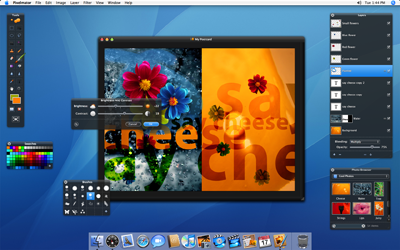
Supported by the open source libraries of ImageMagick, and a skillfully crafted design, I’m beginning to wonder whether this application will be an inexpensive (perhaps free?) alternative to the resource and dollar-hungry Photoshop CS3.
I, for one, will be faithfully awaiting a public beta.
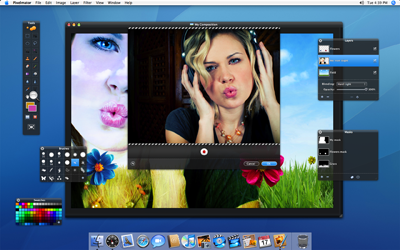
I’ve never been one to shamelessly promote a specific product, but I found myself compelled to spread the word about a little productivity-boosting app called WriteRoom (excuse the horrific pun in this post’s title). Put simply, WriteRoom blocks you from all the flashing widgets, bouncing icons and pretty colours of the OS X interface and gives you a blank “typewriter-style” page, loyally waiting to take down your notes, or record your next blog post (such as I’m doing this very moment).
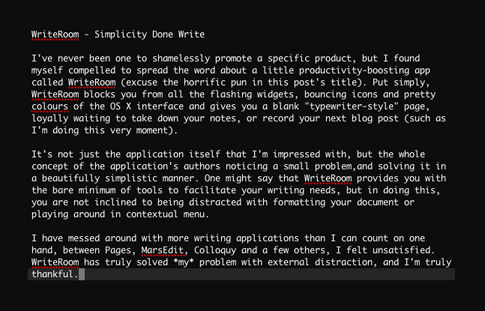
It’s not just the application itself that I’m impressed with, but the whole concept of the application’s authors noticing a small problem, and solving it in a beautifully simplistic manner. One might say that WriteRoom provides you with the bare minimum of tools to facilitate your writing needs, but in doing this, you are not inclined to being distracted with formatting your document or playing around in contextual menu.
I have messed around with more writing applications than I can count on one hand, between Pages, MarsEdit, Colloquy and a few others, I felt unsatisfied. WriteRoom has truly solved *my* problem with external distraction, and I’m truly thankful.
Note: If you’re a Windows user looking for a text-editor in the same vain as WriteRoom, check out its win32 cousin Dark Room.
Why Safari over Firefox?
I have always been a devout fan of Firefox, and it has many excellent features that make it a wonderful browser, and I love supporting open source projects, however, recently I begun to fall back on Safari as my browser of choice for daily browsing. There are a number of reasons why I did this, and I will do my best to explain myself in the following paragraphs.
Reason 1: Fonts
Firefox’s font rendering and anti-aliasing capabilities are far surpassed by that of Safari.app, I am not sure as to the reason why this is, but Firefox seems to not render fonts in the same way that the OS X GUI does, and thus the overall smoothness of type in Firefox is clearly sub par when comparing with the native OS X look. The crisp and smooth look of OS X’s font rendering was a major reason that I switched from Windows to Mac, and Firefox detracts from this experience.
Reason 2: Search Bar
This may seem like a minor thing to many people, but I can’t stand not having the little “x” in the search box in the top right of Firefox (clearing the input from the box). It takes way too much time to use the keyboard to delete the text in there after a search has been completed. On top of this, Safari also automatically clears it for you when a new tab is opened. Allowing you to quickly fire off another Google search, without hassle
Reason 3: Forms
Many people have attacked Safari for being quite restrictive when it comes to styling forms within web pages, form elements cannot be styled with CSS like any other standard page element, they are fixed to the “OS X” style. Many people find this irritating, however I quite like the look, especially when compared to Firefox’s “Windows Default Gray” feel.
Reason 4: Speed
When I was using Firefox as my everyday browser, I had it loaded with 5 or 6 different extensions, which began to seriously impact the browsers performance. Memory leaks were frequent, and the thing was just generally slow.
Reason 5: Aesthetics
To me (I’m running Uno to eliminate the tacky “brushed metal”) Safari just looks better. No unnecessary buttons, clear and clean design.
Reason 6: Download Icons
One really neat “feature” of Safari is that when you download a file, it’s icon actually has an updating progress bar on it. This means when you download multiple files simultaneously, you can easily track their progress simply by glancing at the desktop. This simply removes the necessity for a “downloads” window that only adds to screen clutter.
All that said, there are a few things that Firefox can do that Safari just can’t, and I still use Firefox and it’s wonderful Firebug and Web Developer plugins to test and debug websites. A flexible plugin engine would be really cool for Safari, however I don’t see this happening in the near future.
If any of you think I’m out of my mind for not using Firefox, or can suggest any ways to improve my Firefox experience, let me know.
Inquisitor is a great little addon to Safari that adds an in-depth popup to the search box. It’s easily and quickly accessible with keyboard shortcuts, and now that I’ve finally tried it out, it’s proving to be much more than the gimmick I originally thought it to be.
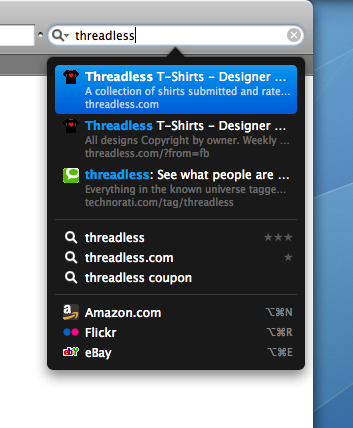
It vaguely reminds me of CoverFlow (now a standard feature in iTunes, and soon to be on the iPod and iPhone), a fun little independantly-developed app that was scooped up by Apple and implemented into their products. I wonder if an Inquisitor-like feature would ever be included in Safari as standard…




















